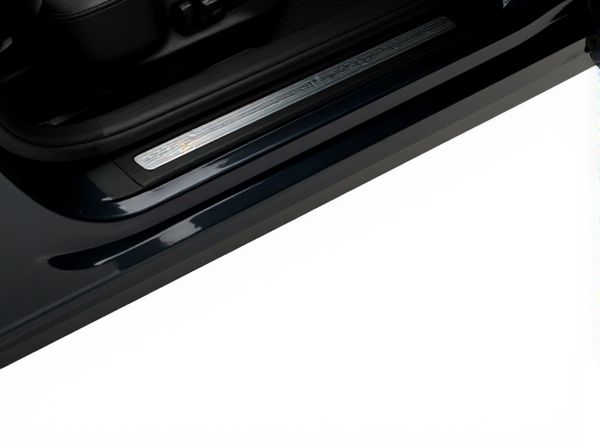
Photo illustration: Integrated Door Sill vs Separate Door Sill
An integrated door sill combines seamlessly with the vehicle's frame, providing enhanced durability and a cleaner aesthetic compared to a separate door sill. Separate door sills often require additional installation steps and may not fit as precisely, potentially leading to gaps that allow dirt and moisture to enter. Choosing an integrated door sill can improve your vehicle's protection against wear and environmental damage while maintaining a sleek, factory-installed look.
Table of Comparison
| Feature | Integrated Door Sill | Separate Door Sill |
|---|---|---|
| Design | Built into car door frame for seamless look | Independent component attached to car frame |
| Durability | Higher durability due to unified construction | Can be prone to loosening or damage over time |
| Installation | Factory-installed, no aftermarket fit needed | Requires additional installation or replacement |
| Maintenance | Low maintenance, easier to clean | May require frequent checks and repairs |
| Cost | Higher upfront cost, better long-term value | Lower initial cost, potential higher maintenance cost |
| Customization | Limited customization options | Offers more customization and design flexibility |
Introduction to Door Sills
Door sills serve as protective thresholds at vehicle entry points, preventing dirt, water, and debris from entering the cabin while enhancing structural integrity. Integrated door sills are built directly into the vehicle's frame, offering seamless protection and a sleek design that reduces installation complexity. Separate door sills are aftermarket or replacement components attached to the existing frame, providing customizable options but potentially requiring additional mounting hardware and maintenance.
What is an Integrated Door Sill?
An integrated door sill is a built-in component of a vehicle's door frame designed to enhance structural strength and improve sealing against water, dust, and noise. Unlike separate door sills, which are attached as aftermarket accessories or replacements, integrated sills are molded as part of the car's bodywork, providing a seamless finish and better corrosion resistance. The integration offers improved durability and a cleaner aesthetic, often contributing to enhanced safety ratings and vehicle longevity.
What is a Separate Door Sill?
A separate door sill is an independent component installed at the base of a door frame to protect the threshold from wear, moisture, and damage. Unlike an integrated door sill, it is not built into the door frame and can be replaced or upgraded individually, offering greater flexibility in maintenance and customization. Separate door sills often come in various materials such as aluminum, rubber, or stainless steel, catering to different durability and aesthetic requirements.
Key Differences Between Integrated and Separate Door Sills
Integrated door sills are built into the vehicle's frame, offering enhanced durability and a seamless design that improves protection against dirt and moisture. Separate door sills function as standalone components, making them easier to replace or customize but potentially less robust and prone to gaps over time. The key differences lie in installation complexity, longevity, and overall aesthetic integration within the vehicle's structure.
Pros and Cons of Integrated Door Sills
Integrated door sills provide a sleek, seamless look and enhanced protection against dirt and moisture, reducing maintenance and improving durability. They are typically more expensive upfront and can be challenging to replace or repair compared to separate door sills, which offer easier customization and cost-effective replacement. Integrated designs may require professional installation to ensure proper fit and function, whereas separate sills allow DIY upgrades and adjustments.
Pros and Cons of Separate Door Sills
Separate door sills offer easy replacement and customization, making them ideal for vehicles requiring frequent maintenance or personalized styling. However, they may be less durable and prone to water and dirt infiltration compared to integrated door sills that provide a seamless fit and better protection. Installation can be more complex and time-consuming, potentially leading to alignment issues if not fitted correctly.
Durability and Maintenance Comparison
Integrated door sills offer enhanced durability due to their seamless construction, which minimizes gaps and reduces exposure to moisture and debris, leading to less wear over time. In contrast, separate door sills, composed of multiple components, are more prone to loosening and damage, requiring frequent inspection and maintenance. Maintenance for integrated door sills typically involves simple cleaning, whereas separate door sills may need periodic tightening or replacement of parts to maintain their structural integrity.
Aesthetic and Design Considerations
Integrated door sills provide a seamless transition between the door frame and floor, enhancing the overall aesthetic by reducing visual breaks and creating a cohesive look. Separate door sills offer more design flexibility, allowing customization of materials and styles to match specific interior themes or architectural details. Choosing between integrated and separate door sills depends on the desired balance between minimalism and decorative expression in the space.
Cost Analysis: Integrated vs Separate Door Sills
Integrated door sills typically incur higher upfront costs due to the complexity of manufacturing and installation, while separate door sills offer more budget-friendly options with easier replacement and maintenance. Long-term cost efficiency favors separate door sills, as damaged components can be individually replaced without affecting the entire assembly. Evaluation of total cost of ownership should consider initial investment, repair expenses, and durability of materials to determine the most economical choice for specific building projects.
Choosing the Right Door Sill for Your Needs
Choosing the right door sill depends on factors like durability, aesthetics, and ease of installation, with integrated door sills offering a seamless, weather-resistant option that enhances overall structural integrity. Separate door sills provide flexibility in replacement and customization, making them ideal for renovations or budget-conscious projects. Evaluating material quality, climate conditions, and door traffic frequency helps determine whether integrated or separate door sills best meet your specific functional and design requirements.
 caratoz.com
caratoz.com